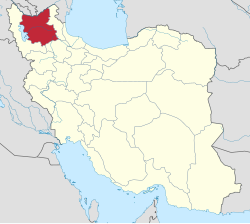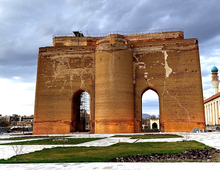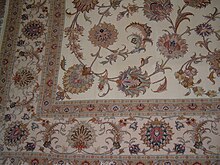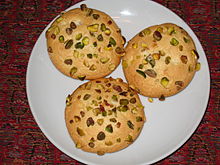East Azerbaijan province
East Azerbaijan Province
Persian: استان آذربایجان شرقی | |
|---|---|
 Location of East Azerbaijan Province within Iran | |
| Coordinates: 38°05′N 46°46′E / 38.083°N 46.767°E[1] | |
| Country | Iran |
| Region | Region 3 |
| Capital | Tabriz |
| Counties | 21 |
| Government | |
| • Governor-general | Torab Mohammadi (Acting) |
| • MPs of Parliament | East Azerbaijan province parliamentary districts |
| • MPs of Assembly of Experts | 1 Mohsen Mojtahed Shabestari 2 Mohammad Taghi Pourmohammadi 3 Ali Malakouti 4 Mohammad Feyz Sarabi 5 Hashem Hashemzadeh Herisi |
| • Representative of the Supreme Leader | Vacant |
| Area | |
| • Total | 45,650 km2 (17,630 sq mi) |
| Population (2016 Census)[2] | |
| • Total | 3,909,652 |
| • Density | 86/km2 (220/sq mi) |
| Time zone | UTC+03:30 (IRST) |
| ISO 3166 code | IR-03 |
| Main language(s) | Persian (official) local languages: Azerbaijani |
| HDI (2017) | 0.785[3] high · 17th |
East Azerbaijan Province (Persian: استان آذربایجان شرقی)[a] is one of the 31 provinces of Iran. Its capital is the city of Tabriz.[4] The province is located in Iranian Azerbaijan, bordering Armenia, the Republic of Azerbaijan, Ardabil Province, West Azerbaijan Province, and Zanjan Province. East Azerbaijan is in Region 3 of Iran, with its secretariat located in its capital city, Tabriz.[5]
At the time of the 2006 National Census, East Azerbaijan Province's population was 3,527,267 in 911,241 households.[6] The following census in 2011 counted 3,724,620 people in 1,085,455 households.[7] At the 2016 census, the province's population was 3,909,652 in 1,223,028 households.[2]
Geography
| Year | Pop. | ±% |
|---|---|---|
| 2006 | 3,527,267 | — |
| 2011 | 3,724,620 | +5.6% |
| 2016 | 3,909,652 | +5.0% |
Religion in East Azerbaijan Province (2016)
Demographic Breakdown by Sex in East Azerbaijan Province (2016)



The province covers an area of approximately 47,830 km², it has a population of around four million people. The province has common borders with the Republic of Azerbaijan, Armenia and Autonomous Nakhchivan in the north, West Azerbaijan in the west, Zanjan in the south, and Ardabil in the east. A fine network of roads and railways connects East Azerbaijan to other parts of Iran and neighboring countries.
The highest point in East Azerbaijan is the volcanic peak of Sahand Mountain at 3,707 m (12,162 ft) of elevation, lying south of Tabriz, whereas the lower-lying areas are around Garmadooz (Ahar). The hills and mountains of the province are divided into three ranges: the Qara Daq Mountains, the Sahand and Bozqoosh Mountains, and the Qaflan Kooh Mountains.
The climate of East Azerbaijan is affected by Mediterranean Continental as well as the cold semi-arid climate. Gentle breezes off the Caspian Sea have some influence on the climate of the low-lying areas. Temperatures run up to 8.9 °C in Tabriz, and 20 °C in Maraqeh, in the winter dropping to −10 to −15 °C at least (depending on how cold the overall year is). The ideal seasons to visit this province are the spring and summer months.
Administrative divisions
At the 1986 census, there were twelve counties in East Azerbaijan Province. By the 1996 census, two additional counties had been formed: Jolfa (from part of Marand), and Malekan (from part of Bonab). Between 1996 and 2002, five new counties were formed: Ajabshir, Azarshahr, Charuymaq, Osku, and Varzaqan.[8] In 2010 Kaleybar was split, with the northern part becoming Khoda Afarin, while the southern part retained the name Kaleybar.[9] After the 2016 census, Hurand County was split off from Ahar County.[10]
The cities of Ahar and Mianeh of East Azerbaijan Province, along with Parsabad and Meshginshahr from Ardabil province, and Piranshahr and Salmas from West Azerbaijan, are six cities in Azerbaijan region that have joined the group of large cities with populations of over 100,000 people due to population changes after the 2016 census.
The population history and structural changes of East Azerbaijan Province's administrative divisions over three consecutive censuses are shown in the following table.
| Counties | 2006[6] | 2011[7] | 2016[2] |
|---|---|---|---|
| Ahar | 147,781 | 150,111 | 154,530 |
| Ajab Shir | 65,741 | 66,746 | 70,852 |
| Azarshahr | 99,286 | 107,579 | 110,311 |
| Bonab | 125,209 | 129,795 | 134,892 |
| Bostanabad | 96,555 | 94,985 | 94,769 |
| Charuymaq | 33,921 | 32,745 | 31,071 |
| Hashtrud | 64,611 | 60,822 | 57,199 |
| Heris | 67,626 | 67,820 | 69,093 |
| Hurand[b] | — | — | — |
| Jolfa | 52,176 | 55,166 | 61,358 |
| Kaleybar | 87,259 | 48,837 | 46,125 |
| Khoda Afarin[c] | — | 34,977 | 32,995 |
| Malekan | 100,366 | 106,118 | 111,319 |
| Maragheh | 227,635 | 247,681 | 262,604 |
| Marand | 229,215 | 239,209 | 244,971 |
| Mianeh | 187,870 | 185,806 | 182,848 |
| Osku | 84,061 | 98,988 | 158,270 |
| Sarab | 132,094 | 131,934 | 125,341 |
| Shabestar | 121,787 | 124,499 | 135,421 |
| Tabriz | 1,557,241 | 1,695,094 | 1,773,033 |
| Varzaqan | 46,833 | 45,708 | 52,650 |
| Total | 3,527,267 | 3,724,620 | 3,909,652 |
Cities
According to the 2016 census, 2,809,424 people (over 71% of the population of East Azerbaijan Province) live in the following cities: [2]
| City | Population |
|---|---|
| Abish Ahmad | 2,715 |
| Achachi | 3,647 |
| Ahar | 100,641 |
| Ajab Shir | 33,606 |
| Aqkand | 2,902 |
| Azarshahr | 44,887 |
| Bakhshayesh | 6,102 |
| Basmenj | 12,692 |
| Benab-e Marand | 4,311 |
| Bonab | 85,274 |
| Bostanabad | 21,734 |
| Duzduzan | 3,627 |
| Gugan | 11,742 |
| Hadishahr | 34,346 |
| Hashtrud | 20,572 |
| Heris | 10,515 |
| Hurand | 4,658 |
| Ilkhchi | 16,574 |
| Javan Qaleh | 700 |
| Jolfa | 8,810 |
| Kaleybar | 9,324 |
| Khamaneh | 3,056 |
| Kharaju | 1,824 |
| Kharvana | 3,353 |
| Khomarlu | 1,902 |
| Khosrowshahr | 21,972 |
| Khvajeh | 4,011 |
| Kolvanaq | 7,465 |
| Koshksaray | 8,060 |
| Kuzeh Kanan | 4,730 |
| Leylan | 6,356 |
| Malekan | 27,431 |
| Mamqan | 11,892 |
| Maragheh | 175,255 |
| Marand | 130,825 |
| Mehraban | 5,772 |
| Mianeh | 98,973 |
| Mobarak Shahr | 4,456 |
| Nazarkahrizi | 1,215 |
| Osku | 18,459 |
| Qarah Aghaj | 6,102 |
| Sahand | 82,494 |
| Sarab | 45,031 |
| Sardrud | 29,739 |
| Shabestar | 22,181 |
| Sharabian | 4,877 |
| Sharafkhaneh | 4,244 |
| Shendabad | 8,489 |
| Siah Rud | 1,548 |
| Sis | 6,106 |
| Sufian | 9,963 |
| Tabriz | 1,558,693 |
| Tark | 2,031 |
| Tasuj | 7,522 |
| Tekmeh Dash | 2,974 |
| Teymurlu | 5,375 |
| Torkamanchay | 7,443 |
| Varzaqan | 5,348 |
| Vayqan | 4,678 |
| Yamchi | 10,392 |
| Zarnaq | 5,343 |
| Zonuz | 2,465 |
Demographics
Most of the inhabitants are ethnic Azerbaijanis who speak a Turkic language related to Turkish.[11]
In Qarajadaḡ (today Arasbaran), that is, the region between the Aras river and the Sabalan mountain range, there are six Shiʿite, Turkic-speaking tribes of Kurdish origin: Chalabianlu, Mohammadkhanlu, Hosaynkhanlu, Hajialilu, Hasanbeiglu and Qarachorlu.[12]
History
East Azerbaijan is one of the most archaic territories in Iran. During the reign of Alexander III of Macedon in Iran (331 BCE), a warrior known as Attorpat led a revolt in this area, then a territory of the Medes, and thereafter it was called Attorpatkan. Since then this vicinity has been known as Azarabadegan, Azarbadgan and Azarbayjan.
Islamic researchers proclaim that the birth of the prophet Zoroaster was in this area, in the vicinity of Lake Orumieh (Chichesht), Konzak City. Needless to say, this province was subject to numerous political and economical upheavals, attracting the interest of foreigners. The Russians in particular have tried to exert a lasting influence in the region over the past 300 years, occupying the area on numerous occasions. The constitutionalist movement of Iran began here in the late 19th century.
Ethnic tensions in Azerbaijan can legally trace their origins back to the colonialist policies of Imperial Russia and later the Soviet Union. In a cable sent on 6 July 1945 by the Central Committee of the Communist Party of the Soviet Union, the local Soviet commander in Russian (northern) held Azerbaijan was instructed as such:
Begin preparatory work to form a national autonomous Azerbaijan district with broad powers within the Iranian state and simultaneously develop separatist movements in the provinces of Gilan, Mazandaran, Gorgan, and Khorasan".[13]
In 1945, the Soviet Union helped set up the Azerbaijan People's Government in what is now East Azerbaijan.
Culture


From a cultural point of view, the most outstanding features are the language, Azerbaijani, and folklore of this region. The language of Azerbaijan is originally "a branch of the Iranian languages known as Azari" (see Ancient Azari language).[14][15][16] However, the modern Azeri language is a Turkic language very closely related to the language of Republic of Azerbaijan and Turkey.[17] Apart from this, the province also boasts numerous learned scholars, gnostics, several national poets such as Mowlana Baba Mazeed, Khajeh Abdol Raheem Aj Abadi, Sheikh Hassan Bolqari, and Abdolqader Nakhjavani, to name a few, and the contemporary poet Ostad Mohammad Hossein Shahriyar. The current leader of Iran, Ali Khamenei, also originally comes from this region.
Iran's Cultural Heritage Organization has registered 936 sites of historical significance in the province. Some are contemporary, and some are from the antiquity of ancient Persia. "Zahak Citadel", for example, is the name of an ancient ruin in East Azerbaijan, which according to various experts, was inhabited from the second millennium BC until the Timurid era. First excavated in the 1800s by British archeologists, Iran's Cultural Heritage Organization has been studying the structure in 6 phases.[1]
East Azerbaijan enjoys a rich compendium of Azeri traditions. Many local dances and folk songs continue to survive among the various peoples of the province. As a longstanding province of Iran, Azerbaijan is mentioned favorably on many occasions in Persian literature by Iran's greatest authors and poets.
East Azerbaijan today


East Azerbaijan province is an industrial centre of Iran. East Azerbaijan province has over 5000 manufacturing units (6% percent of national total). The value of product from these units in 1997 was US$374 million (373 billion rials = 4.07% of the national total). Total investments were valued at US$2.7 billion (2.4513 trillion rials) in 1997.[18]
Some of the major industries in East Azerbaijan are glass industries, paper manufacturing, steel, copper and nepheline syenite, oil refinery, petrochemical processing facilities, chemical products, pharmaceutical processing, foundries, vehicle and auto-parts industries, industrial machines, agricultural machines, food industries, leather, and shoe industries.
East Azerbaijan has an excellent position in the handicraft industry of Iran, which has a large share in the exports of the province. Tabriz carpets are widely known around the world and in international markets for their vibrant designs and colors. At present there are about 66,000 carpet production units in the province, employing some 200,000 people. The annual production of these carpets is roughly 792,000 m², which comprises more than 70% of Iran's carpet exports. 35% of all Iranian carpets are produced in East Azerbaijan. East Azerbaijan province is also one of the richest regions of Iran in natural minerals, with 180 mines in 1997, of which 121 units are currently in operation, and the rest are being planned.
UNESCO has two Biosphere reserves in East Azerbaijan province. One in Lake Urmia and the other at Arasbaran.
Colleges and universities
East Azerbaijan also has some of Iran's prestigious universities including:
- Sahand University of Technology[2]
- Tabriz University of Medical Sciences
- University of Tabriz[3] Archived 2016-10-29 at the Wayback Machine
- Azerbaijan University of Tarbiat Moallem
- Tabriz Islamic Arts University Archived 2018-09-24 at the Wayback Machine
- University of Maragheh
- Engineering and Technical College of Bonab[4] Archived 2019-10-02 at the Wayback Machine
- Islamic Azad University of Bonab
- Islamic Azad University of Tabriz
- Islamic Azad University of Shabestar
- Islamic Azad University of Maragheh
- Islamic Azad University of Miyaneh
- University College of Nabi Akram, Tabriz
Notable people
- Qatran Tabrizi, poet
- Ahmad Kasravi, historian
- Samad Behrangi
- Sattar Khan, revolutionary leader
- Bagher Khan, revolutionary leader
- Gayk Bzhishkyan
- Kazem Sadegh-Zadeh
- Parvin E'tesami, poet
- Ali Daei, Iranian soccer player
- Karim Bagheri, soccer star
- Iraj Mirza, poet and politician
- Maqsud Ali Tabrizi
- Ivan Galamian
- Hassan Roshdieh
- Shams Tabrizi, mystic
- Vartan Gregorian, President of Carnegie Corporation
- Ali Salimi
- Ali Soheili, Prime Minister of Iran
- Ebrahim Hakimi, Prime Minister of Iran
- Mahmud Jam, Prime Minister of Iran
- Mohammad Hossein Shahriar
- Asadi Tusi is buried here
See also
![]() Media related to East Azerbaijan Province at Wikimedia Commons
Media related to East Azerbaijan Province at Wikimedia Commons
Notes
- ^ Also romanized as Āzarbāijān-e Sharqi; Azerbaijani: شرقی آذربایجان اوستانی
- ^ Separated from Ahar County after the 2016 census[10]
- ^ Separated from Kaleybar County after the 2006 census[9]
References
- ^ OpenStreetMap contributors (22 May 2024). "East Azerbaijan Province" (Map). OpenStreetMap. Retrieved 22 May 2024.
- ^ a b c d "Census of the Islamic Republic of Iran, 1395 (2016)". AMAR (in Persian). The Statistical Center of Iran. p. 03. Archived from the original (Excel) on 13 November 2020. Retrieved 19 December 2022.
- ^ "Sub-national HDI - Area Database - Global Data Lab". hdi.globaldatalab.org. Retrieved 13 September 2018.
- ^ Habibi, Hassan (21 June 1369). "Approval of the organization and chain of citizenship of the elements and units of the country's divisions of East Azerbaijan province, centered in the city of Tabriz". Qavanin (in Persian). Political-Defense Commission of the Government Board. Archived from the original on 23 October 2021. Retrieved 5 December 2023.
- ^ "همشهری آنلاین-استانهای کشور به ۵ منطقه تقسیم شدند (Provinces were divided into 5 regions) (1 Tir 1393, Jalaali)". Hamshahri Online (in Persian). 22 June 2014. Archived from the original on 23 June 2014.
- ^ a b "Census of the Islamic Republic of Iran, 1385 (2006)". AMAR (in Persian). The Statistical Center of Iran. p. 03. Archived from the original (Excel) on 20 September 2011. Retrieved 25 September 2022.
- ^ a b "Census of the Islamic Republic of Iran, 1390 (2011)". Syracuse University (in Persian). The Statistical Center of Iran. p. 03. Archived from the original (Excel) on 16 January 2023. Retrieved 19 December 2022.
- ^ "Iran Counties". www.statoids.com. Retrieved 25 April 2024.
- ^ a b Rahimi, Mohammad Reza (7 September 1389). "Letter of approval regarding country divisions in Kaleybar County". Laws and Regulations Portal of the Islamic Republic of Iran (in Persian). Ministry of Interior, Council of Ministers. Archived from the original on 26 September 2022. Retrieved 20 November 2023.
- ^ a b Jahangiri, Ishaq (6 November 2018). "Approval letter regarding reforms and divisional changes in East Azerbaijan province". Islamic Council Research Center (in Persian). Ministry of Interior, Council of Ministers. Archived from the original on 6 October 2021. Retrieved 3 December 2023.
- ^ Aghajanian, Akbar (1983). "Ethnic Inequality in Iran: An Overview". International Journal of Middle East Studies. 15 (2). Cambridge University Press: 211–224. doi:10.1017/S0020743800052284. ISSN 0020-7438. JSTOR 162990. Retrieved 21 May 2024.
- ^ "Welcome to Encyclopaedia Iranica".
- ^ Decree of the CC CPSU Politburo to Mir Bagirov, CC Secretary of the Communist Party of Azerbaijan, on "measures to Organize a Separatist Movement in Southern Azerbaijan and Other Provinces of Northern Iran". Translation provided by The Cold War International History Project at The Woodrow Wilson International Center for Scholars.
- ^ Paul, Ludwig (1998a). "The position of Zazaki among West Iranian languages" in Melville (1999). Charles Melville (ed.). Proceedings of the Third European Conference of Iranian Studies: Mediaeval and modern Persian studies. Reichert. ISBN 978-3-89500-104-8.
- ^ Dalby, Andrew (1998). Dictionary of Languages: The Definitive Reference to More Than 400 Languages. Columbia University Press. p. 156. ISBN 978-0-231-11568-1., p. 496.
- ^ Yarshater, E. (1988). "Azerbaijan vii. The Iranian Language of Azerbaijan". Encyclopaedia Iranica, Vol. III, Fasc. 3. pp. 238–245.
- ^ See also Ahmad Kasravi, Azari or The Ancient Language of Azerbaijan (Āzari yā Zabān-e Bāstān-e Āzar'bāi'jān), in Persian, third edition (Tehran, 1325 AH/1946). This text can be downloaded free of charge from the bibliography section (Ketāb Shenāsi) of: Ahmad Kasravi, 1891-1946.
- ^ According to the information released by the office of the provincial governor.
External links
- Official website Archived 2011-03-03 at the Wayback Machine
- Cultural Heritage Organization of East Azerbaijan
- The Union for Handwoven Carpets of East Azerbaijan
- Recent Photos from Azerbaijan
- Arasbaran UNESCO Biosphere Reserve
- Lake Urmia UNESCO Biosphere Reserve
- East Azerbaijan Research Park net portal Archived 2015-02-21 at the Wayback Machine
- Azerbaijan Archived 2006-10-19 at the Wayback Machine entries in the Encyclopædia Iranica
- Bahram Moshiri's brief talk on Azerbaijan. [5] Archived 2012-07-24 at the Wayback Machine


